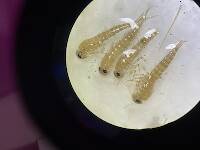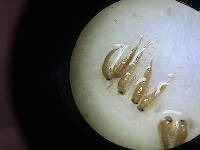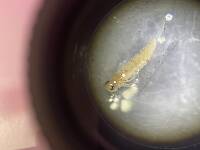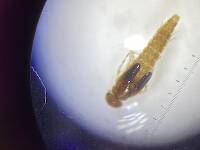
Salmonflies
Pteronarcys californica
The giant Salmonflies of the Western mountains are legendary for their proclivity to elicit consistent dry-fly action and ferocious strikes.
Featured on the forum

This one was surprisingly straightforward to identify. The lack of a sclerite at the base of the lateral hump narrows the field quite a bit, and the other options followed fairly obvious characteristics to Clostoeca, which only has one species, Clostoeca disjuncta.

Troutnut is a project started in 2003 by salmonid ecologist Jason "Troutnut" Neuswanger to help anglers and
fly tyers unabashedly embrace the entomological side of the sport. Learn more about Troutnut or
support the project for an enhanced experience here.
Scruffyfish has attached this picture to aid in identification. The message is below.

Entoman on Mar 13, 2012March 13th, 2012, 10:23 am EDT
Scruffyfish -
Thanks for the new photo. Its resolution is high enough that the lingering questions about the tails can be answered. BTW, Spence & Paul are right. Great video link. I've watched it three times. Amazing! Anybody reading this thread should check it out.
As to the tails, the new photo clearly shows that the long one is the terminal filament. This would pose a problem if it weren't for the fact that this genus is notorious for delicate tails. Damaged and missing tails seem to be more common than not in photos of these guys. If you look closely, the tails are blunt at the ends signifying they've lost some length, and while the terminal is longer, it is also visibly thinner.
The strongest case can be made for my initial speculation, L. johnsoni (Little Black Quill). The size is at the small end of the leptophlebid scale and the other species found in NH have severely truncated terminals. There is some confusion about this as Eric mentioned. Even Schwiebert himself wrote in his revised Nymphs that this species has a truncated tail. He was wrong. This species has a thin terminal that is as long or slightly subequal to the cerci. It is so unique in this regard that The mayflies of North and Central America, Edmunds, et. al. has the species listed as an exception in its dichotomous key. This character is also mentioned in the body of the genus topic.
These leptophlebids are amazing insects. A lot of angling literature reports that they are poor swimmers. Nothing could be further from the truth. While perhaps not having the sprint capacity of the baetids, they more than make up for that with endurance. Noted entomologist George Edmunds documented that they have been known to migrate out of their natal waters in search of suitable hatching environs as far as 400 yds. against current in a single day! Not bad for a half inch critter... :)
Thanks for the new photo. Its resolution is high enough that the lingering questions about the tails can be answered. BTW, Spence & Paul are right. Great video link. I've watched it three times. Amazing! Anybody reading this thread should check it out.
As to the tails, the new photo clearly shows that the long one is the terminal filament. This would pose a problem if it weren't for the fact that this genus is notorious for delicate tails. Damaged and missing tails seem to be more common than not in photos of these guys. If you look closely, the tails are blunt at the ends signifying they've lost some length, and while the terminal is longer, it is also visibly thinner.
The strongest case can be made for my initial speculation, L. johnsoni (Little Black Quill). The size is at the small end of the leptophlebid scale and the other species found in NH have severely truncated terminals. There is some confusion about this as Eric mentioned. Even Schwiebert himself wrote in his revised Nymphs that this species has a truncated tail. He was wrong. This species has a thin terminal that is as long or slightly subequal to the cerci. It is so unique in this regard that The mayflies of North and Central America, Edmunds, et. al. has the species listed as an exception in its dichotomous key. This character is also mentioned in the body of the genus topic.
These leptophlebids are amazing insects. A lot of angling literature reports that they are poor swimmers. Nothing could be further from the truth. While perhaps not having the sprint capacity of the baetids, they more than make up for that with endurance. Noted entomologist George Edmunds documented that they have been known to migrate out of their natal waters in search of suitable hatching environs as far as 400 yds. against current in a single day! Not bad for a half inch critter... :)
"It's not that I find fishing so important, it's just that I find all other endeavors of Man equally unimportant... And not nearly as much fun!" Robert Traver, Anatomy of a Fisherman
Entoman on Mar 13, 2012March 13th, 2012, 12:01 pm EDT
These photo links illustrate the tail issue.
Here is an example of what I believe is a male of the same species from NH:
http://bugguide.net/node/view/184905/bgimage
This one is an example of the larger and more common species L. cupida. Notice the truncated terminal filament:
http://bugguide.net/node/view/17553/bgimage
Here is an example of what I believe is a male of the same species from NH:
http://bugguide.net/node/view/184905/bgimage
This one is an example of the larger and more common species L. cupida. Notice the truncated terminal filament:
http://bugguide.net/node/view/17553/bgimage
"It's not that I find fishing so important, it's just that I find all other endeavors of Man equally unimportant... And not nearly as much fun!" Robert Traver, Anatomy of a Fisherman
PaulRoberts on Mar 13, 2012March 13th, 2012, 12:48 pm EDT
Impressive bug!
There's noticeable venation (possibly pigmented) in the wings too, something I don't think we see in other three tailed mays -Yes?
There's noticeable venation (possibly pigmented) in the wings too, something I don't think we see in other three tailed mays -Yes?
Crepuscular on Mar 13, 2012March 13th, 2012, 1:09 pm EDT
I think we have a winner! :) Leptophlebia, come on down!
I think Eric called it first...Cudos Eric.
Spence
I remember hearing something about a blind squirrel...
Actually I do a substantial amount of work
In and around vernal pools starting this time of year and see quite a few Letophlebia immatures, as well as some adults.
Entoman on Mar 13, 2012March 13th, 2012, 1:53 pm EDT
There's noticeable venation (possibly pigmented) in the wings too, something I don't think we see in other three tailed mays -Yes?
Interesting observation on leptophlebids, Paul. By pigmentation, I assume you mean contrasting color pigmentation. The big burrowers and costal veins in some ephemerellids aside, I think you may be right. Though, there may be some examples out there that would make liars of us.:)
Here's a photo of Rhithrogena debilis I recently placed in the hatch page that illustrates your point. In the hand it looked to be a uniform smokey dun.
http://www.troutnut.com/fullsize/picture-im_regspec/4408
"It's not that I find fishing so important, it's just that I find all other endeavors of Man equally unimportant... And not nearly as much fun!" Robert Traver, Anatomy of a Fisherman
Lastchance on Mar 13, 2012March 13th, 2012, 2:31 pm EDT
I guess I should have also mentioned, there is a stream about half mile from the pond and also a large lake. After re-posting I googled Leptophlebia and saw a Youtube video of the nymph and hatching that looks very close to my mayfly. http://www.youtube.com/watch?v=XDTMFVHxXLk
Awesome video. Thanks for posting it.
Bruce
Scruffyfish
Posts: 6
Posts: 6
Scruffyfish on Mar 13, 2012March 13th, 2012, 3:09 pm EDT
Entoman.
I haven't seen any males with the big eyes, in the flies I've collected. Some where I have other photos that may show them. I would have sworn they were hendrickson, except for the lack of the large eyes.
Here is an example of what I believe is a male of the same species from NH:
http://bugguide.net/node/view/184905/bgimage
I haven't seen any males with the big eyes, in the flies I've collected. Some where I have other photos that may show them. I would have sworn they were hendrickson, except for the lack of the large eyes.
Entoman on Mar 13, 2012March 13th, 2012, 5:42 pm EDT
Hi Scruffyfish -
Yeah, the differences are subtle and not readily apparent if a person doesn't know what differences to look for (or understand the scientific lingo used to point them out). For comparison here's a female Ephemerella subvaria (Hendrickson)
http://www.troutnut.com/specimen/505 so you can toggle back and forth between the two looking for the characters I describe below:
1. Hind wing costal projection - See the shallow rounded point on the lower leading edge of the little wing? This is absent on your specimen.
2. Equal caudal filaments that approximate body length - You can't fully see the tails in these photos, but they are as described. With Leptophlebia johnsoni they are much longer, and usually not equal.
3. Forewings w/ basally detached marginal intercalaries - look at the trailing edge of the big wing. Notice the really short veins in between the full length ones that don't attach to anything except the edge? These are lacking in yours.
4. Forelegs similar in color to other sets; forefemora and foretibae similar in length - Notice how long the longest leg segment is in your specimen? And that the front legs are darker?
5. Prominent pronotum - this is the shell behind the head in front of the mesonotum (the shell covering the middle thoracic segment where the big wings are attached). Notice on your specimen it's shallow and slopes quickly to the neck?
These are some of the most noticeable differences that separate the two species.
I hope this helps. If not, let me know.
Yeah, the differences are subtle and not readily apparent if a person doesn't know what differences to look for (or understand the scientific lingo used to point them out). For comparison here's a female Ephemerella subvaria (Hendrickson)
http://www.troutnut.com/specimen/505 so you can toggle back and forth between the two looking for the characters I describe below:
1. Hind wing costal projection - See the shallow rounded point on the lower leading edge of the little wing? This is absent on your specimen.
2. Equal caudal filaments that approximate body length - You can't fully see the tails in these photos, but they are as described. With Leptophlebia johnsoni they are much longer, and usually not equal.
3. Forewings w/ basally detached marginal intercalaries - look at the trailing edge of the big wing. Notice the really short veins in between the full length ones that don't attach to anything except the edge? These are lacking in yours.
4. Forelegs similar in color to other sets; forefemora and foretibae similar in length - Notice how long the longest leg segment is in your specimen? And that the front legs are darker?
5. Prominent pronotum - this is the shell behind the head in front of the mesonotum (the shell covering the middle thoracic segment where the big wings are attached). Notice on your specimen it's shallow and slopes quickly to the neck?
These are some of the most noticeable differences that separate the two species.
I hope this helps. If not, let me know.
"It's not that I find fishing so important, it's just that I find all other endeavors of Man equally unimportant... And not nearly as much fun!" Robert Traver, Anatomy of a Fisherman
Quick Reply
Related Discussions
Topic
Replies
Last Reply
1
Sep 9, 2008
by GONZO
by GONZO
2
Feb 6, 2017
by Crepuscular
by Crepuscular









